RUSSIA Sept 10-27, 2014
After long flights over 2 days (Vancouver to New York JFK, a 10 hour lay-over in a not so nice airport, an 8 hour flight to Helsinki, Finland, and a 45 minute flight to St. Petersburg), I arrived pretty knackered. But the $640 price was worth it. The bus and then metro to downtown was easy but finding the hostel was a challenge with all street addresses in Cyrillic and few English speakers.
For the first time in 3 years, I was traveling in a country where the people looked just like at home – varying color eyes, hair and facial features. But here there are many more superficially attractive women. Probably language knowledge is worse here than anywhere else (comparable to Japan). The availability of English language TV, of which there is little of in Russia, is one predictor of English ability. The weather was unusually nice for my entire 17 days in Russia. It apparently rains most days a year. Prices are very comparable to home.
One gets nickled and dimed at most Russian attractions. After paying a general admission, one must pay extra to see the special attractions. It can get expensive.
It is extremely helpful to understand the Cyrillic alphabet. It is possible to decipher many place names.
38 roubles to the $US.
Russian Food: Pelmeni are dumplings of Russian cuisine that consist of a filling wrapped in thin, unleavened dough. Pirog is a baked case of dough with a sweet or savoury filling. Pirogi are common in Eastern European cuisines. Pirogi are characterised as “the most popular and important dish” and “truly national goods” of Russian cuisine, “ubiquitous in Russian life”. Pirozhki (“small pie”) are a Russian puff pastry which consists of individual-sized baked or fried buns stuffed with a variety of fillings
ST PETERSBURG (pop. 4.8 million)
History. A battle with Sweden was fought here in 1240 and again in the Great Northern War of 1700-21 when Peter built the Peter and Paul Fortress in 1703 founding the city. The capital was moved from Moscow. Artisans and architects came from all over Europe, so that by 1725, when Peter died, the city had 40,000 citizens and 90% of Russia’s trade came through St Petersburg. Between 1741 and 1825, during the reigns of Elizabeth, Catherine the Great and Alexander I, it became a cosmopolitan city with an imperial court of famed splendor. They commissioned great series of palaces, government buildings and churches, turning it into one of Europe’s grandest capitals.
The emancipation of serfs in 1861 and industrialization that peaked in the 1890s brought a flood of poor workers into the city, leading to squalor, disease and festering discontent. The city became a hotbed of strikes and political violence, and was the hub of the 1905 revolution, sparked by ‘Bloody Sunday’, when a strikers’ march to petition the tsar was fired on by troops. In 1914, in a wave of patriotism, the city’s name was changed to the Russian style Petrograd.
In 1917, a general strike and mutiny of the army led to the end of the monarchy and eventually Lenin’s Bolshevik Party formed the Soviet government. Fearing a German attack the capital was moved back to Moscow in 1918.
Renamed Leningrad after Lenin’s death in 1924, the city became the hub of Stalin’s 1930s industrialization program. By 1939, the population was 3.1 million and accounted for 11% of Soviet industrial output.
When Germany attacked the USSR in June 1941, its armies took only 2½ months to reach Leningrad. As the birthplace of Bolshevism, Hitler swore to wipe the city form the face of the earth, besieging it until January, 1944. About a million people died (by comparison, the USA and Britain suffered about 700,000 dead between them in all of WWII). Food was practically nonexistent, people ate their pets, paste behind wallpaper, leather and eventually, most turned to cannibalism. But the city survived. It took until 1960 for the population to exceed WWII’s levels.
In 1991, after the fall of the Soviet Union, the city’s citizens voted to bring back the name of St Petersburg. In the anarchic early 90s, it often seemed like the local ‘Mafia’ were more in charge than the elected officials, who proved to be equally corrupt. Starting in 2003, enormous sums were spent to spruce up the city for the tercentary celebrations. Locals Vladimir Putin and Dmitry Medvedev, show off the city to visiting heads of state.
Originally an uninhabited swamp spread over many islands in the delta of the Neva River where it empties into the Gulf of Finland, it has become one of the world’s great cities. Grand buildings line Nevsky Prospect and the many canals and riverbanks. Called the ‘Venice of Russia’, there are 342 bridges in the city. Its main sites are fairly well centered in the historic heart. It is easy to walk everywhere and the metro, like those elsewhere, easy to navigate.
St Petersburg has the appearance of a prosperous city. I saw no homeless people, there is no garbage, and the only panhandler was an occasional elderly woman. All cars are foreign with a preponderance of BMWs, Audis, Mercedes, Japanese and Korean vehicles and some Chevs and Fords. Ladas are distinctly rare. I saw little evidence of alcohol abuse or poverty.
At least six days are necessary to see most of the sites including the several palace complexes outside town. On my third evening here, I saw Tchaikovsky’s Swan Lake performed at the Mikhailovsky Theatre. For my first ballet, I was impressed. I checked out the story line on Wikipedia to understand what was going on. The present Russian versions of the ballet have happy endings. The $80 cost here was a third of the already sold-out Swan Lake at the Bolshoi in Moscow.
Hermitage.
One of the world’s great museums (comparable to the Louvre and MOMA), it is an equally confusing place to visit. About 5% of the enormous collection of over 3 million items is on view in 5 buildings that from the outside look like one. The exterior is a green, white and gold profusion of columns, windows and recesses; the roof is topped with rows of statues. The Neva River is on one side and the huge Palace Square on the other. The main building is the Winter Palace built in 1754. It alone has 1057 rooms, three stories and 117 staircases. It doesn’t help to plan as you never know where you are.
The Hermitage’s collection began with Catherine the Great, one of the greatest art collectors of all time. Nicholas I greatly enriched the collection and opened it to the public in 1852. In the post revolutionary period, the collection increased three-fold as many valuable private collections were seized by the state. In 1948 it incorporated the renowned collections of post-Impressionistic and Impressionistic paintings of two Moscow industrialists. The result is a comprehensive history of Western European art.
It is not cheap – general admission is 400R, plus 300R each for the Treasury Room and Gold Room (about $26). It would be best to buy tickets online ($25.95) which gives access to the main museum plus four other separate buildings not included above, allows visits over 2 days and allows you to bypass the enormous queues for tickets. Daypacks, water and food are not allowed inside and I walked out exhausted after 7 hours.
The interiors are magnificent with grand staircases, the Romanov’s private apartments, Peacock Clock and of course all the great artists of Europe. I paid the extra fees to see the Gold Room (the most interesting were the Synthian gold from the 4th-7th centuries BC) and the Treasure Room with the over-the-top appetites of the Russian leaders in full evidence.
Dvotsvaya Ploshchad (Palace Square).
This massive square is one of the most impressive and historic places in the city. In its centre is the 47.4m Alexander Column commemorating the 1812 victory over Napoleon. Bloody Sunday occurred here. Across the square from the Hermitage is the imposing General Staff Building of the Russian Army, with a branch of the Hermitage inside.
Church of the Savior on Spilled Blood.
This has become my favorite church easily comparable to the Burgos Cathedral in Spain (or even the lovely tiny church in Fort Good Hope, NWT, Canada). It was built between 1883-1907 on the spot where Alexander II was assassinated. It took 24 years to build and 27 years to restore, reopening in 1997. The outside has multiple colourful domes and the crests of all Russian states in mosaics.
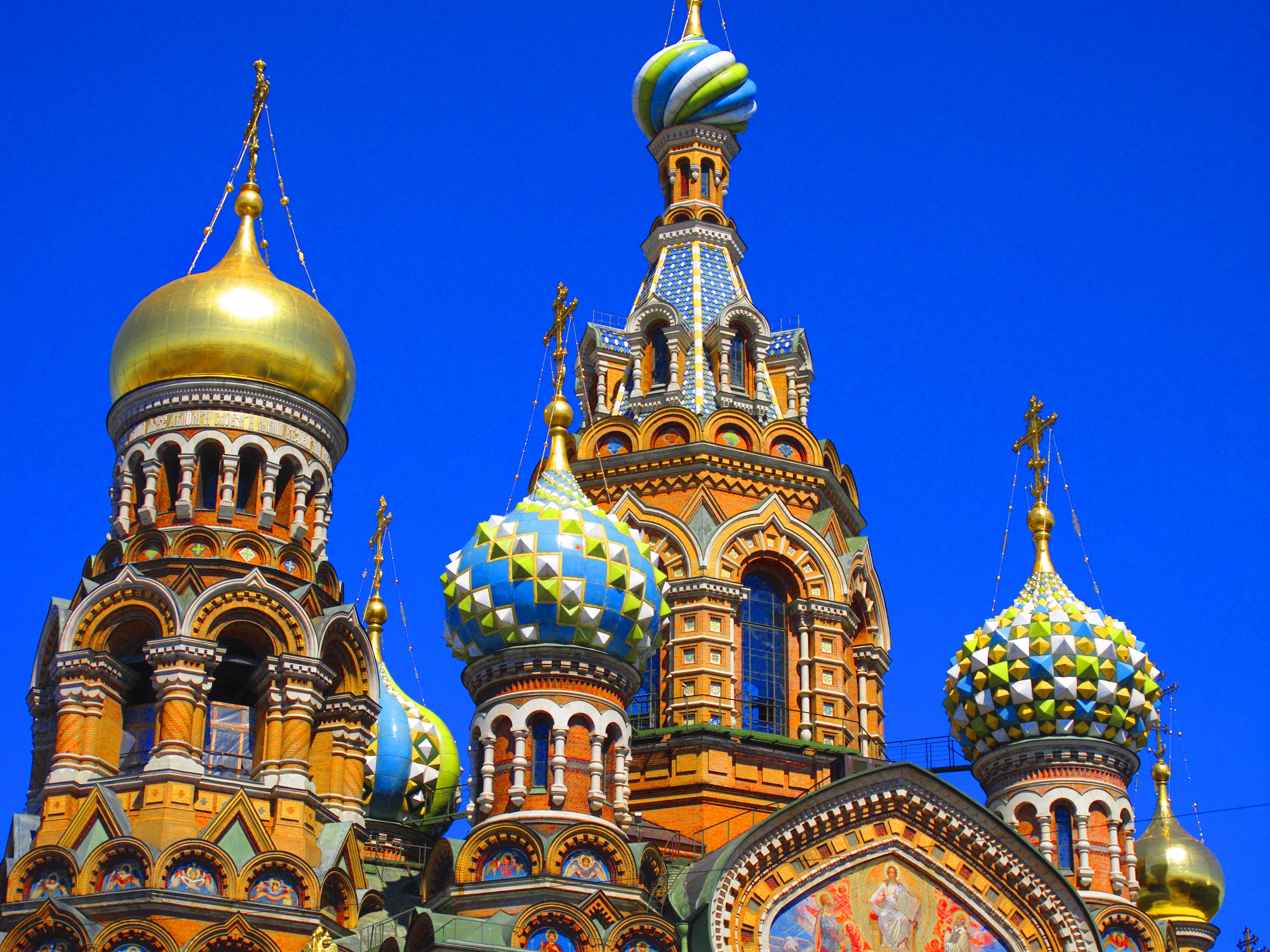
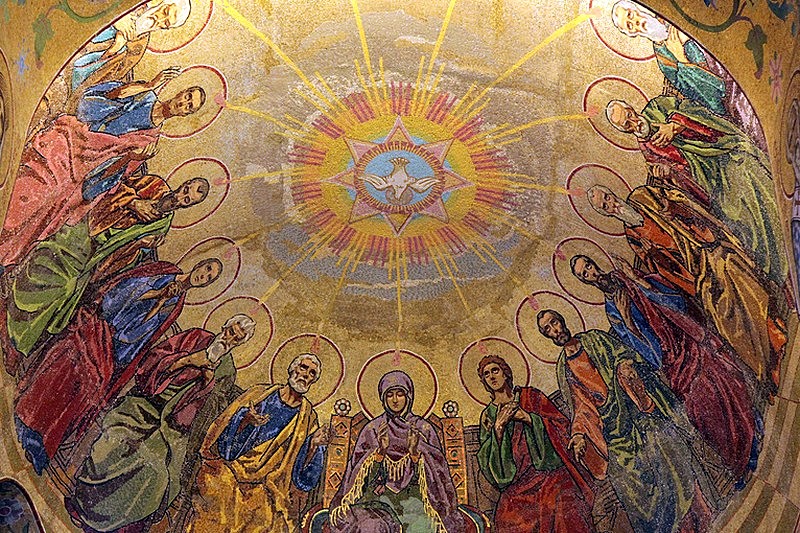

It took 30 artists to restore the interior’s incredible 7000 sq. m of mosaics that cover every inch of wall, arch and ceiling. The marble floor is dazzling as is the marble surrounding the iconostasis.
Russian Museum. Housed in the former Mikhailovsy Palace (built in 1819-1829 for Mikhail, the brother of tsars Alexander I and Nicholas I in compensation for not having the chance to be on the throne), it contains the country’s finest collections of Russian art. The museum also has sections in three other city palaces.
St Isaac’s Cathedral. The golden dome of this mammoth church (101.5m tall, 111 by 97m inside, dome has a diameter of 25.8m) dominates the St Petersburg skyline. The lavish 4,100 sq. m interior is a monument to marble and malachite, mosaic iconoclasts and art. Special ships and a railway had to be built to carry from Finland the 48 massive granite pillars on the outside – each 17m tall pillar weighs 119 tons. It was a museum to atheism during the Soviet years and is now a museum. A separate ticket is required to climb the 262 steps up to the colonnade around the drum of the dome for panoramic views of the city.

Bronze Horseman. This impressive statue of Peter the Great on a stallion sits on a massive piece of granite.
Peter and Paul Fortress.
Across the Neva River from the Hermitage is this first structure in St Petersburg.
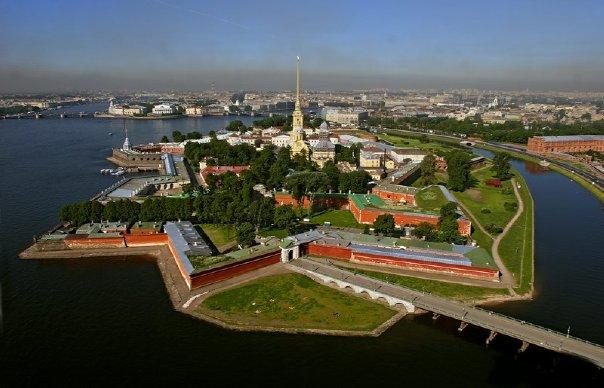
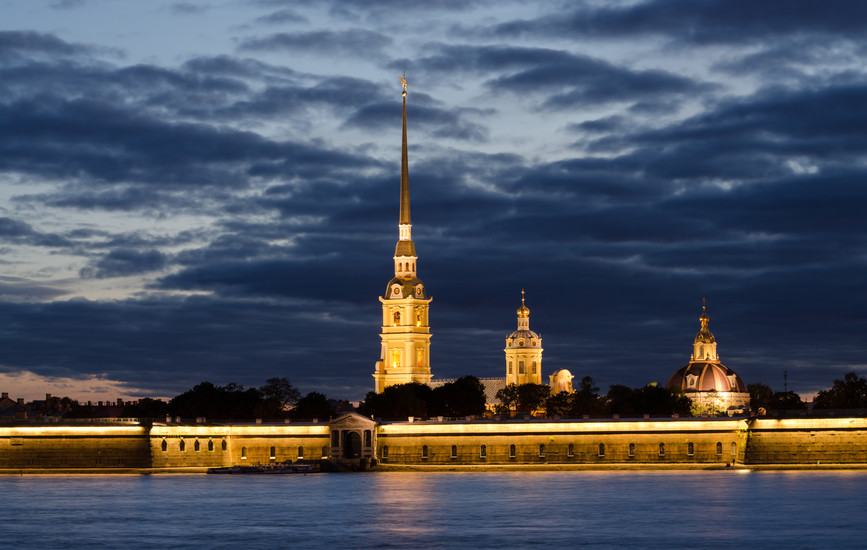
Inside is the St Peter and Paul Cathedral with its 122m-tall needle thin, gilded spire. Its interior is the resting place for all of Russia’s pre revolutionary rulers including the remains of Nicholas II and his murdered family (which were discovered and placed here in 1998). The fortress never really saw any action and its main use up to 1917 was as a political prison. A beach on the river is full of sunbathers in the summer and the site of the Polar Bear Swim on New Years.
There are many more museums, attractions, and neighbourhoods to visit in St Petersburg.
Museum of Ethnology. Showcases most ethnic groups in Russia)
Singer Building. Once the headquarters of the sewing machine company, now a bookstore.
Kunstkamera. The city’s first museum founded in 1714 infamous for its ghoulish collection of monstrosities – preserved freaks, two-headed fetuses, and odd body parts – all collected by Peter the Great; also displays of native people from around the world.
Stieglitz Museum of Decorative and Applied Arts. Baron Alexander von Stieglitz (1814–84), a millionaire philanthropist built it to accommodate Stieglitz’s private collection of rare glassware, porcelains, tapestries, furniture, and tiled stoves. It was not until the fall of the Soviet Union that slow and painstaking restoration began.
Kazan Cathedral. St Petersburg’s most picturesque.
The Museum of Defense and Blockade of Leningrad
Cemetery at the Alexander Nevsky Monastery
Russian Vodka Museum
Grand Choral Synagogue

Heritage Storage Facility
Monument to the Heroic Defenders of Leningrad
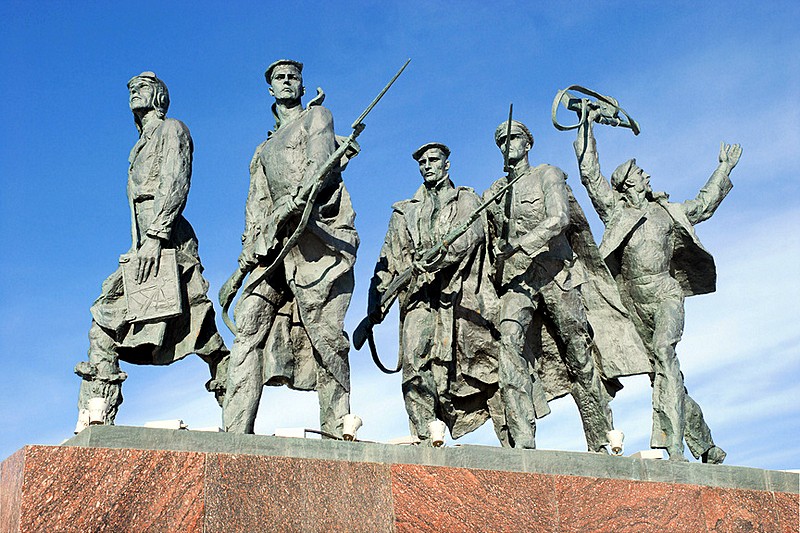
Udelnaya Flea Market
Bank Bridge Pedestrian bridge
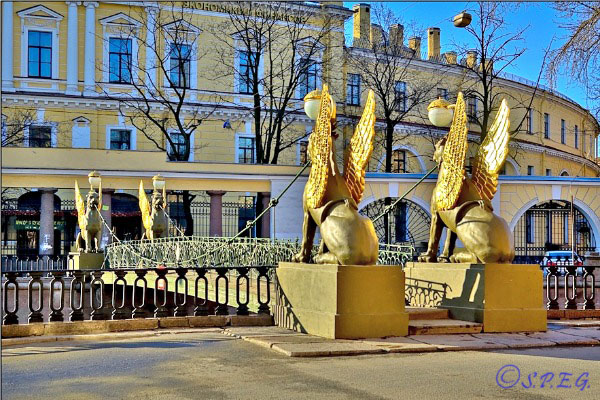
Bridge of Four Lions Pedestrian Bridge
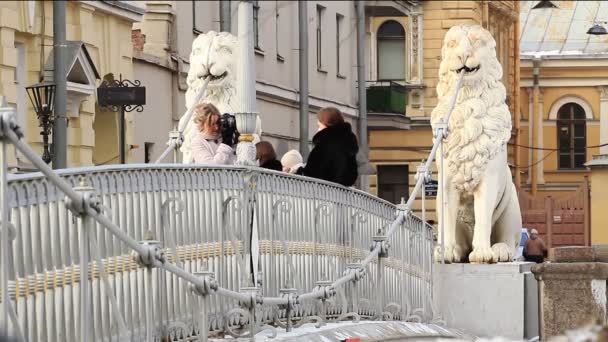
Passage is an élite department store on Nevsky Avenue founded in 1848. The Passage premises have long had associations with the entertainment industry and houses the Komissarzhevskaya Theatre.

Bolshoy Dom is an office building at 4 Liteyny Avenue, the headquarters of the Federal Security Service of Russia (FSB) and Main Department of the Ministry of Internal Affairs. It was originally constructed in 1931–32 for the Joint State Political Directorate (OGPU), the secret police of the Soviet Union at the time. Bolshoy Dom became the subject of numerous urban legends due to its association with the secret police. The common conspiracy theory about the building is that it contains a large amount of secret underground floors, leading to jokes about Bolshoy Dom being the tallest building in Saint Petersburg. There is also a legend that the building survived the Siege of Leningrad during World War II because Nazi Germany was aware that German prisoners of war were housed in the top floor, preventing it from being bombed.
Lakhta Center is an 87-story skyscraper, 462 metres (1,516 ft) tall, the tallest building in Russia, the tallest building in Europe, and the 13th-tallest building in the world. The Lakhta Center is also the second-tallest structure in Russia and Europe, behind Ostankino Tower in Moscow. Construction started in 2012; it was topped out in January 2018. The tower’s curtain wall is also the world’s largest cold-bent facade by area.

Red Banner Textile Factory. Built in 1926–1937. The factory is still partly in use as storage space. By 2017 the chimney was removed and the building was described as being in a “poor state of repair”.
Others visited: Leningrad Zoo, Planet Neptune Oceanarium, Saint Petersburg Planetarium, Peter the Great Botanical Garden.
Saint Petersburg Metro. Open since 1955, it has typical Soviet designs and features exquisite decorations and artwork making it one of the most attractive and elegant metros in the world. Due to the city’s unique geology, the it is one of the deepest metro systems in the world and the deepest by the average depth of all the stations. The system’s deepest station, Admiralteyskaya, is 86 metres below ground. Serving about 2 million passengers daily, it is also the 19th busiest metro system in the world.
Avtovo Metro Station. The grand columns and marble interior of the station make a commuter wonder if they have arrived at a subway stop or at a palace. The ceiling of the station is supported by 46 columns, 30 made of marble and 16 that are decorated with glass. The theme of the station is the defence of Leningrad during the Siege of the Second World War. At the end of the platform, there is a large mosaic mural depicting a woman holding a child. It was from here in 1955 that the first train departed, making the St Petersburg metro the second operational subway in the country, after Moscow.
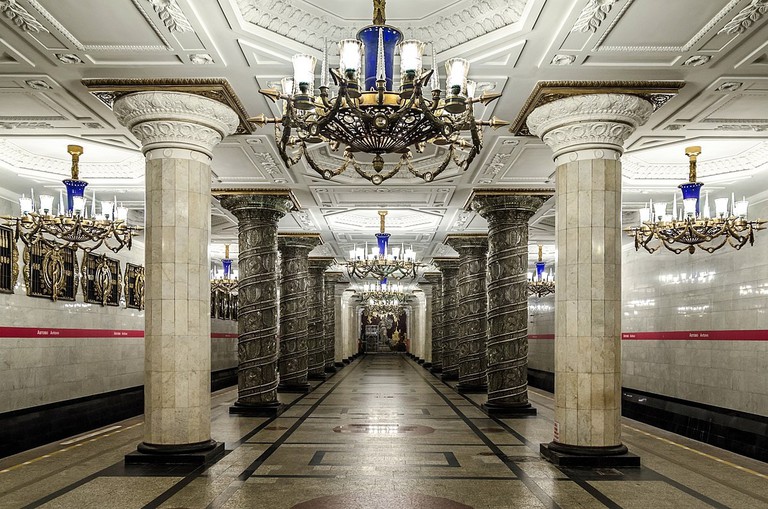
Kirovsky Zavod Metro Station. The name of the station comes from the Kirovsky factory located in the vicinity, and the general theme of the station is the development of socialist industry. The haut-reliefs on the walls of the station depict the various industries of the former Soviet Union: electricity, oil, coal mining and metal production. The station is decorated with grey-coloured marble. The station was the first to use a lighting system that imitated daylight but was later replaced by ordinary electric lighting.

Narvskaya – large relief of Lenin and carvings.
Ploshchad Vosstaniya – Lenin and Stalin representations.
Allegro is a high-speed train service between Helsinki and St. Petersburg that started December 2010. It reduced travel time from 5½ hours to 3′ 27′.
Saspan is a high-speed train between St. Petersburg at the centrally located Moskovsky Station 4 hours later arrive at Leningradskaya Station in the heart of Moscow. Opened in December 2009, the Sapsan (Russian for Peregrine Falcon).has a maximum speed of 250km/h. The convenience rivals traveling by air. The short flight time of one hour between St. Petersburg and any of the seven airports that service Moscow lures travellers at first. It is common to spend three or more hours in traffic getting to and from the city-centres to the airports.
Arctic and Antarctic Museum
Dostoyevsky Museum
Faberge Museum
Military Historical Museum of Artillery, Engineers and Signal Corps
Museum of Hygiene
Museum of Political History of Russia
Nabokov House
Zoological Museum
Other Palaces & Castles
Beloselskiy-Belozerskiy Palace is a 1747 Neo-Baroque palace at the intersection of the Fontanka River and Nevsky Prospekt. Elena Pavlovna produced its lavish appearance. In addition to the Belosselsky Belozersky wealth stemming from their south Urals metal works, Elena Pavlovna also inherited a fortune from her own family, the Bibikovs. She had the old building knocked down and had a new palace built that became the venue of the most lavish balls and concerts in St. Petersburg. Major renovations in 1847-48, (piano nobile, concert hall, Van Loo paintings, and palace church — all a dazzling Rococo appearance and later a vast library and a Slavic revival chapel. It became a municipal cultural centre with chamber concerts for small audiences and a large wax work.
Kamenny Island Palace is a former imperial palace on the south-western promontory of Kamenny Island in St. Petersburg. Commissioned in the 1770s by Catherine II for her son Paul. Since the early 20th century the palace has fallen into neglect. It remained in use as a convalescence home for soldiers throughout the Soviet period. It is currently closed for major repairs.
Menshikov Palace on Vasilyevsky Island 1710. was the first stone building in the city. Since 1981, it has served as a branch of the Hermitage Museum with a collection of Russian art of the late 17th-early 18th century.
Moika Palace or Yusupov Palace was once the primary residence of the House of Yusupov. The building was the site of Grigori Rasputin’s murder in the early morning of December 17, 1916. Built around 1776, the Yusopov family acquired more than 40,000 works of art, including works by Rembrandt, jewelry, and sculptures decorated the palace. Following the Russian Revolution, the palace was nationalised and its works of art were largely relocated to the Hermitage and other museums.Today the palace serves as a “Palace of Culture for Educators”. Second floor reception areas and that part of the building associated with Rasputin’s murder, are maintained as a museum open to public tours.
The building dates to the 1740s. The Fountain House became one of the main cultural centres of St. Petersburg. Currently it is the State Museum of Theatre and Musical Art, with a collection of historical musical instrument. The southern wing of the palace also houses the Anna Akhmatova Memorial Museum, in the apartment where the great 20th century poet lived from the mid-1920s until 1952.
Stroganov Palace. The Soviets declared the palace a national museum chronicling the lifestyle of the Russian nobility. In 1929 the museum was shut down, and much of its contents (including some priceless paintings and objets d’art) were taken to the Hermitage Museum. The palace was handed over to a botanical institute. The Ministry of Shipbuilding occupied the premises for half a century, starting in 1939. In 1988 the palace was given to the Russian Museum and became a branch housing some of its exhibitions. The dilapidated building underwent a thorough and painstaking restoration process between 1991 and the present moment. In keeping with Rastrelli’s original design, its walls are now painted light pink (rather than dark green, as they were in the mid-20th century). It is one of the few Baroque structures on Nevsky Prospect to preserve its original appearance.
Marble Palace is one of the first Neoclassical palaces slightly to the east from New Michael Palace. (1768). The palace takes its name from its opulent decoration in a wide variety of polychrome marbles. A rough-grained Finnish granite on the ground floor is in subtle contrast to polished pink Karelian marble of the pilasters and white Urals marble of capitals and festoons. Panels of veined bluish gray Urals marble separate the floors, while Tallinn dolomite was employed for ornamental urns. In all, 32 disparate shades of marble were used to decorate the palace. Currently it has a permanent collection of the Russian State Museum, notably “Foreign artists in Russia (18th and 19th centuries)” and the Peter Ludwig Museum at the Russia Museum featuring canvases by Andy Warhol and other Pop Art idols.
Yelagin Palace is a Palladian villa on Yelagin Island which served as a royal summer palace during the reign of Alexander I. Constructed in 1822, it currently houses a collection of objets d’art from the 18th and 19th centuries, notably precious glassware.
AROUND ST PETERSBURG
Peterhof
This was the country residence of Peter the Great constructed from 1716-1723, 28 kms west of St Petersburg on the Gulf of Finland. The Palace was enlarged twice by Elizabeth and Catherine to its present grand size. Only a few walls remained after it was heavily bombed by the Soviets in January, 1942 to prevent Hitler from using it for his invasion celebration. The restoration is remarkable. It is best known for the surrounding park and incredible display of fountains, all fed by gravity. I arrived by bus and was let off outside the upper park. You walk past several wonderful fountains and enter the lower park to the side of the palace.

Peterhof is expensive to see everything (entrance to the lower park 500R, Grand Palace 500R and 250R each for the 13 palaces and other attractions spread throughout the lower park for a grand total of 4250R or about $112). For some unknown reason, I could not buy a ticket to the Grand Palace (with the poor English, the only answer I could get was NO!), so it ended up being not that expensive a day. The main group of 140 fountains just below the palace called the Grand Cascade, turned on at 11AM and this was apparently the last display for the season. Many of the fountains are gold animals and men and make an imposing site. The water then flows down a canal to the Gulf of Finland. The grounds are impressive and have fountains all over the place.

I took the hydrofoil (650R) back to St Petersburg over the Gulf of Finland and up the Neva River to near the Hermitage.
Pavlovsk
South of St Petersburg and 4km past Pushkin, is the Grand Palace constructed by Catherine the Great in 1781-6 for her son Paul. The original palace was burnt down 2 weeks after liberation in 1945 when a Soviet soldier’s cigarette detonated a German mine. The restoration is also remarkable. The huge Pavlovsk Great Park (at 534 hectares the largest park in Europe) is Unesco World Heritage listed and filled with rivers, lakes, avenues, statues and temples that could take a whole day to explore. I arrived by bus, walked through the park to the palace, and realizing I did not have time to also see Pushkin in the same day, elected to abbreviate my visit.
Pushkin (Tsarskoe Selo)
25 km south of St Petersburg, the vast, baroque Catherine Palace was built between 1744 and 1796 and remodelled by Catherine the Great. After being almost totally destroyed by the Nazis in WWII, it too has been beautifully restored. With a gaudy blue and white exterior, it has 20 spectacular rooms, the most famous of which is the Amber Room. The original was created from exquisitely engraved amber panels given to Peter the Great by the King of Prussia in 1716. The panels were combined with woodcarvings, mirrors, agate and jasper mosaics, but were plundered by the Nazis and later exhibited at Konigsberg’s Castle that was in ruins by 1945. Presumably, the Amber Room was destroyed along with it. Or was it? In 2004, Putin and German Chancellor Gerhardt Schroder presided over the new $18 million restoration of the Amber Room, restored largely with German funds. Some believe the original remains hidden away but the mystery continues. It is an amazing room. The wood parquet floors throughout the palace are also outstanding. The name Tsarskoe Selo was changed in 1937 to Pushkin after Russia’s favorite poet.
On one side of the palace is the wonderful Catherine Park. A large lake is surrounded by an interesting collection of buildings (several baths, concert halls and palaces) that can easily take two hours to explore.
Beside Catherine Palace is Alexander Park and Palace built for Alexander I but he didn’t like it and never used it. Nicholas II, the last Russian tsar, was its main tenant and used it for much of his reign. Only 3 rooms are open and it is not much visited. One could easily spend all day here to see everything.
Other sites around St Petersburg include Gatchina (another grand palace built by Catherine the Great for her favorite, Greagory Orlov) and Kronshtadt (a fortress out in the Gulf of Finland with a cathedral as its highlight).
KRONSTADT is a municipal town on Kotlin Island, 30kms west of Saint Petersburg near the head of the Gulf of Finland. Population: 43,005. It is Saint Petersburg’s main seaport. Traditionally, the seat of the Russian admiralty and the base of the Russian Baltic Fleet were located in Kronstadt guarding the approaches to Saint Petersburg.
Kronstadt has been a place of pilgrimage for Orthodox Christians for many years due to the holy memory of Saint John of Kronstadt. Bus and water tours to Kronstadt are taken daily from Saint Petersburg.
Fort Alexander
Naval Cathedral
Kabotazhnaya Gavan Rear Light
Kronshtadt Maritime Museum
I took the high-speed Sapsan train 4½ hours to Moscow during the day to see the surrounding countryside (uninspiring flat country with trees). The trains top speed is 250km/hour but this did not seem that fast – the 650km distance with 4 very brief stops indicates a speed closer to 150km/hour. I sat next to a very pleasant woman who was a lawyer from St Petersburg. She had lived in Israel for 11 years.